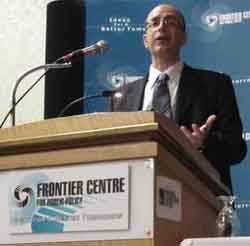 THUNDER BAY – Special to NNL – According to the Stockholm Resilience Center (www.stockholmresilience.org), the concept of resilience refers to the capacity of a social-ecological system to withstand perturbations from various types of shock and to then renew itself afterwards. In other words, if a system is resilient, it can deal with change. The forest crisis in Northwestern Ontario was a major economic shock to the region’s economy that resulted in massive employment losses and yet if one looks at the region’s economy and especially its major center – Thunder Bay – one cannot help but notice the resilience of the economy. Thunder Bay, which has seen three of its four pulp mills close and numerous sawmill job losses over the period 2003-2009, has witnessed increases in many indicators of economic activity suggesting that the economy has been able to adapt to the shock of the forest sector loss.
THUNDER BAY – Special to NNL – According to the Stockholm Resilience Center (www.stockholmresilience.org), the concept of resilience refers to the capacity of a social-ecological system to withstand perturbations from various types of shock and to then renew itself afterwards. In other words, if a system is resilient, it can deal with change. The forest crisis in Northwestern Ontario was a major economic shock to the region’s economy that resulted in massive employment losses and yet if one looks at the region’s economy and especially its major center – Thunder Bay – one cannot help but notice the resilience of the economy. Thunder Bay, which has seen three of its four pulp mills close and numerous sawmill job losses over the period 2003-2009, has witnessed increases in many indicators of economic activity suggesting that the economy has been able to adapt to the shock of the forest sector loss.
The relatively resilient economy in Northwest Ontario is being driven by three broad forces: the continued transition towards a knowledge based economy in the region, the expenditure on public sector infrastructure and the growth and development of the mining sector in the region. The knowledge economy in Northwestern Ontario is being spearheaded by the development of the Thunder Bay Regional Health Sciences Centre (TBRHSC), the Northwestern Ontario School of Medicine (NOSM) and the research work of the Thunder Bay Regional Research Institute (TBRRI). The TBRHSC employs 2,500 people and has an annual budget of 280 million dollars. In addition, the TBRRI is recruiting scientists from around the world to conduct work in the areas of molecular medicine and imaging systems and new medical research associated private sector companies are being spawned such as Sentinel and Tornado. The other key blocks of the regional knowledge sector economy include Lakehead University with a total employment (full & part-time) of 2,000 and an annual operating budget of approximately 100 million dollars and Confederation College with 760 employees (full and part-time) and an annual operating budget of almost 70 million dollars. In addition, the region’s manufacturers such as Bombardier and GRK fasteners also use knowledge intensive and skilled workers and have also seen growth in their activity. Bombardier in particular is assured a future in urban transit given the increasing demand for such systems in an urbanizing world.
With respect to public sector infrastructure, the Northwest region has recently seen millions of dollars in provincial road construction and improvements as part of a planned 273 million dollar investment in regional highways. There are 32 projects in Northwestern Ontario nearing completion involving 494 kilometres of highway and nine bridges, which have created 1,900 construction related jobs. In the Thunder Bay region, there is a waterfront development project underway as well as substantial recent investments in roads and bridges, a new library and trail development.
To read the rest of this article, please visit: The Northern Economist

